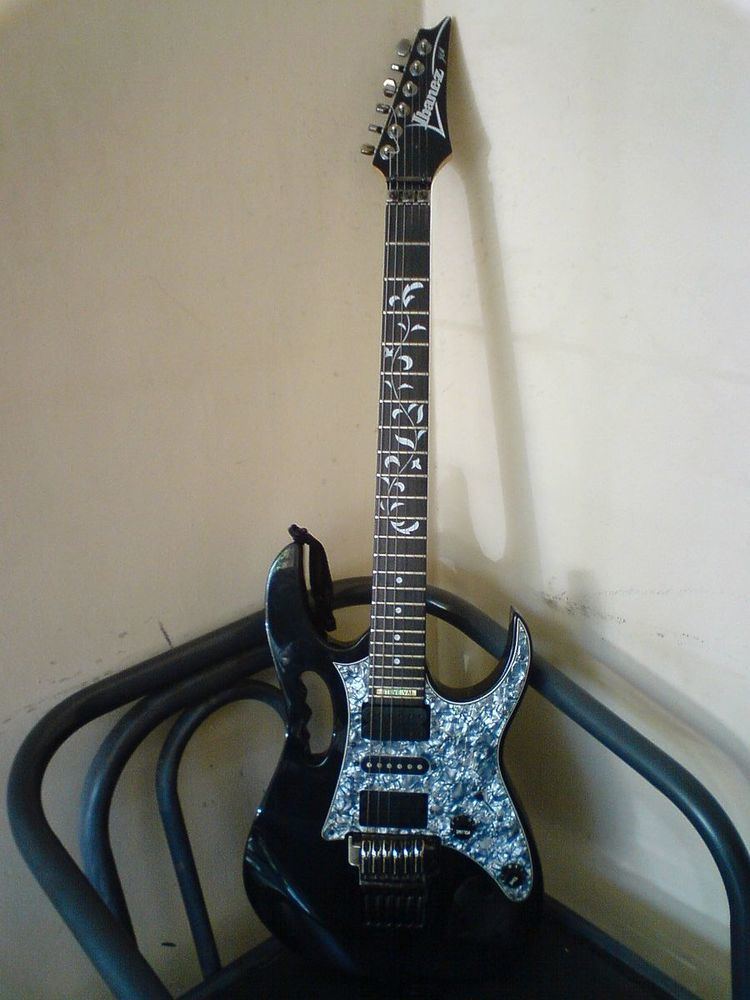 | ||
Superstrat is a name for an electric guitar design that resembles a Fender Stratocaster but with differences that clearly distinguish it from a standard Stratocaster, usually to cater to a different playing style. Differences typically (but not necessarily) include more pointed, aggressive-looking body and neck shapes, different woods, increased number of frets, usage of humbucking pickups and locking tremolo systems, most commonly the Floyd Rose.
Contents
- Genesis custom modifications
- Mass production
- Fenders response
- Gibsons response
- End of superstrat era
- References
There is no formal definition of a superstrat; the categorisation is still largely left to popular opinion and depends greatly on the artist(s) associated with a particular model and how it is marketed. Superstrats are generally suited for heavy metal music played with high-gain distortion.
Genesis, custom modifications
With the increased popularity in heavy metal music during the early 1980s, guitarists began seeking out guitars more suited to the new style, both in terms of looks (more "pointy" aggressive designs) and playability (ease of playing and larger tone that sounds pleasant with hi-gain amplification). Guitarists such as Ritchie Blackmore, Uli Jon Roth and Dave Murray had used Fender Stratocasters, but each had minor modifications made to his instrument to suit his individual playing style.
Eddie Van Halen was one of the first to build a guitar with superstrat characteristics. Dissatisfied with the performance of then-available original stock model commercial guitars, Van Halen sought to create a hybrid instrument that would suit his acrobatic playing style. The stock single-coil pickups of a Fender Stratocaster were noisy, and lacked the output necessary to drive an amplifier into hard distortion (characteristic of the Van Halen sound), but the body shape and wide pitch range of the Fender fulcrum tremolo appealed to him. An avid tinkerer, Van Halen assembled a Boogie Bodies Stratocaster body with a thin, 21-fret maple neck and a humbucking Gibson PAF pickup in the bridge slot. This guitar, known as the "Frankenstrat" was featured on Van Halen's debut album Van Halen, and pictured on the album cover. It was later repainted with a top coat of red, and has had different humbuckers over the years, some of them custom-wound.
While many believe Van Halen's 1977 Frankenstrat to be the first Superstrat, Michael Hampton of Parliament-Funkadelic often used a sunburst Stratocaster with 3 humbucking pickups and a reversed headstock during the band's tours in the mid-to-late '70s. This guitar can be seen on the DVD George Clinton: The Mothership Connection, which was filmed in 1976.
Soon, other guitarists and luthiers would also apply similar custom modifications to their instruments. Many sources cite Grover Jackson as one of the first (and most influential) guitar makers to have crafted custom shop guitars with all the features of superstrats, doing so as early as 1981. Later all these improvements were integrated in the factory-produced Jackson Soloist model.
Mass production
Starting about 1983–1984, companies such as Kramer, Jackson, Charvel, Yamaha, Aria, Ibanez, and Hamer started mass production of superstrat design guitars due to growing market demand. The rising popularity of heavy metal music led to a new generation of guitarists that employed fast and complex techniques which demanded thinner and more versatile guitar necks and stable tremolo systems. Some examples of guitars marketed to this specific audience include:
During the rest of the 1980s, due to the style's huge marketing success, most guitar companies had at least one model of superstrat in mass production.
Makers of superstrat models besides the companies mentioned elsewhere in this article also included Fernandes, Schecter, Carvin and ESP.
Fender's response
Fender responded to the superstrat fashion in the mid-1980s, producing a number of models based on the standard Stratocaster.
Fender also released several superstrat models, such as Talon, under Fender/Heartfield name from 1989 to 1993.
Gibson's response
Gibson also produced some models inspired by the superstrat:
End of superstrat era
In early and mid-1990s, heavy metal and particularly shredding declined in popularity, in favor of grunge, nu metal, alternative metal and other styles. The popularity of superstrats also declined, in favor of guitars more suited to these new styles. Companies that relied on superstrats as a major part of their target market suffered heavy losses and went out of business or were bought by larger corporations:
Nevertheless extended-fretboard superstrats remain popular in the mid-2010s among metal and shred guitarists in particular, and are produced by guitar manufacturers of all sizes. Additionally, some Stratocaster modifications which were strongly associated with the superstrat, such as the Floyd Rose tremolo system and especially the inclusion of humbucking pickups, have become widely available from stock on 22-fret bolt-on neck instruments which are often seen as Stratocaster variants rather than superstrats, including several stock models of official Fender Stratocaster.
